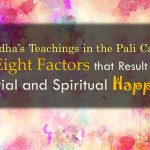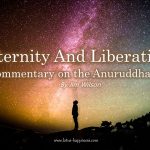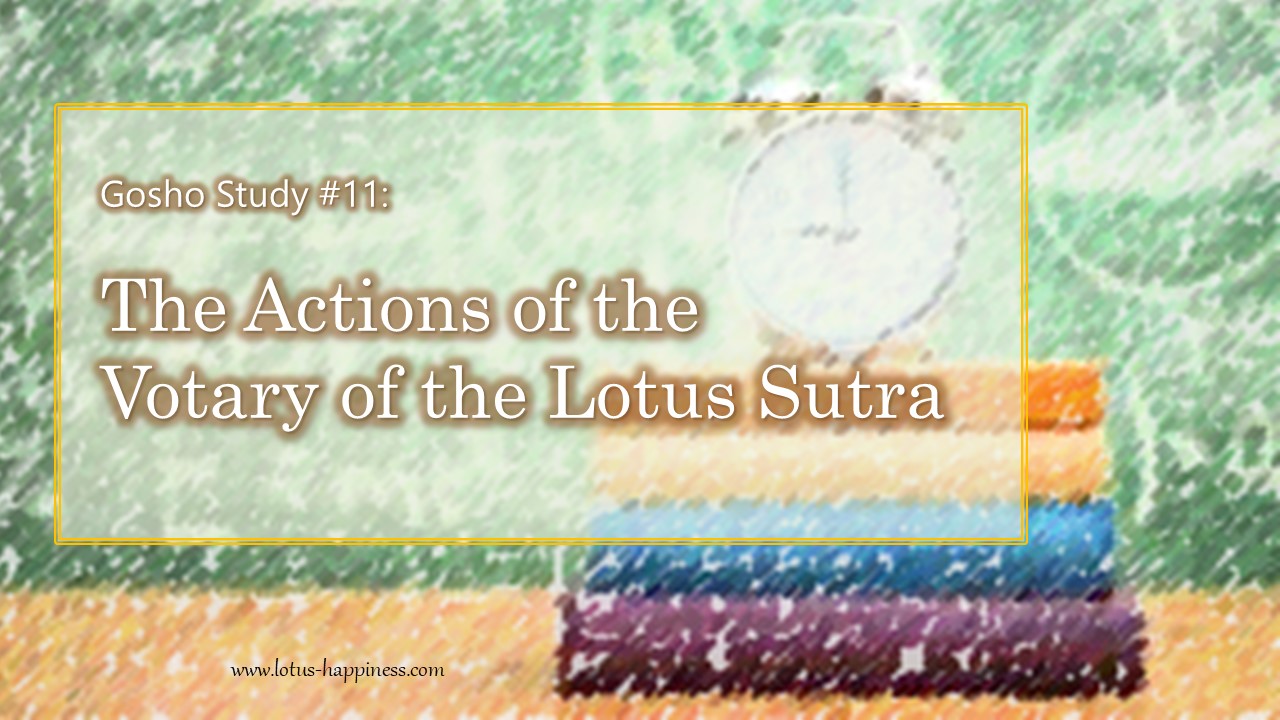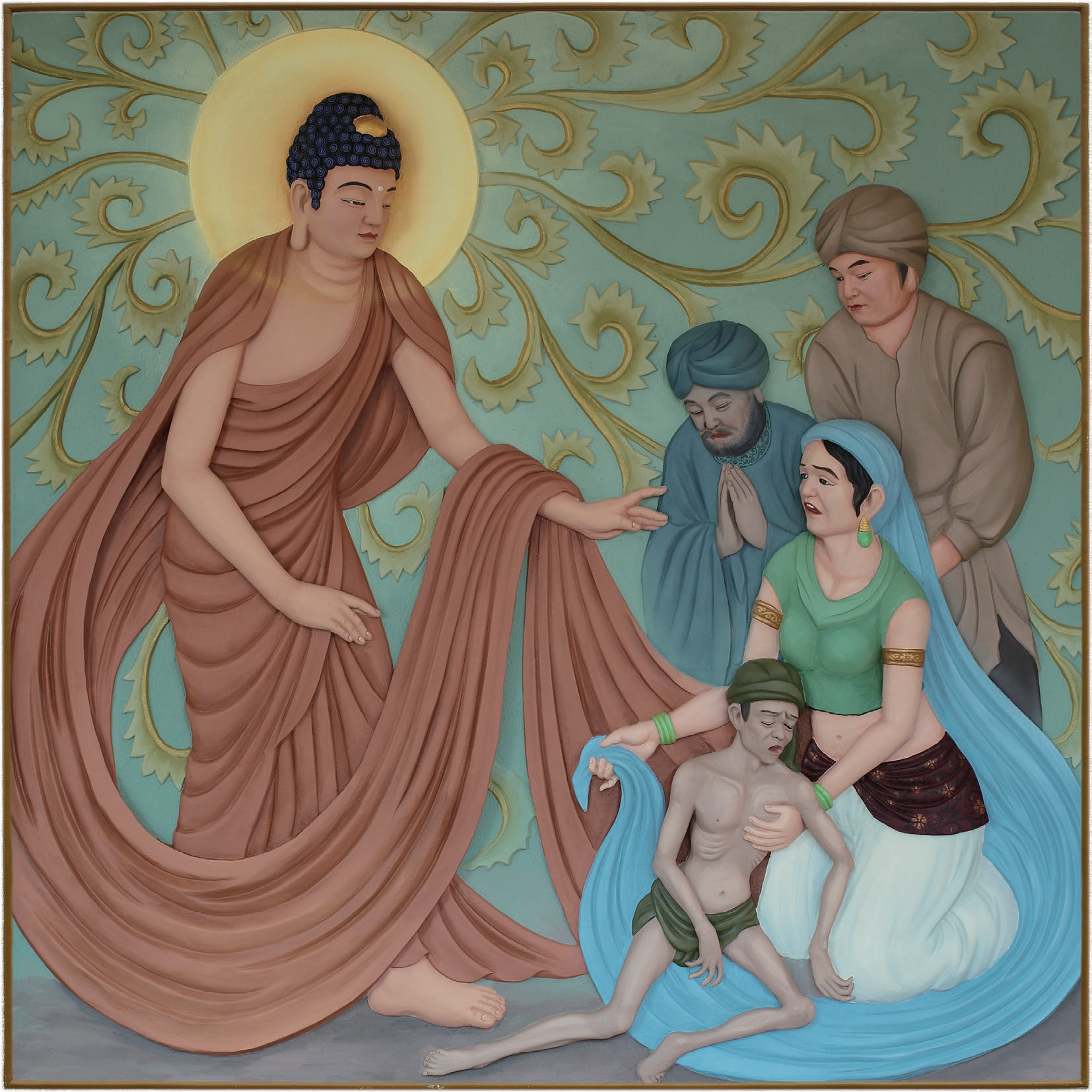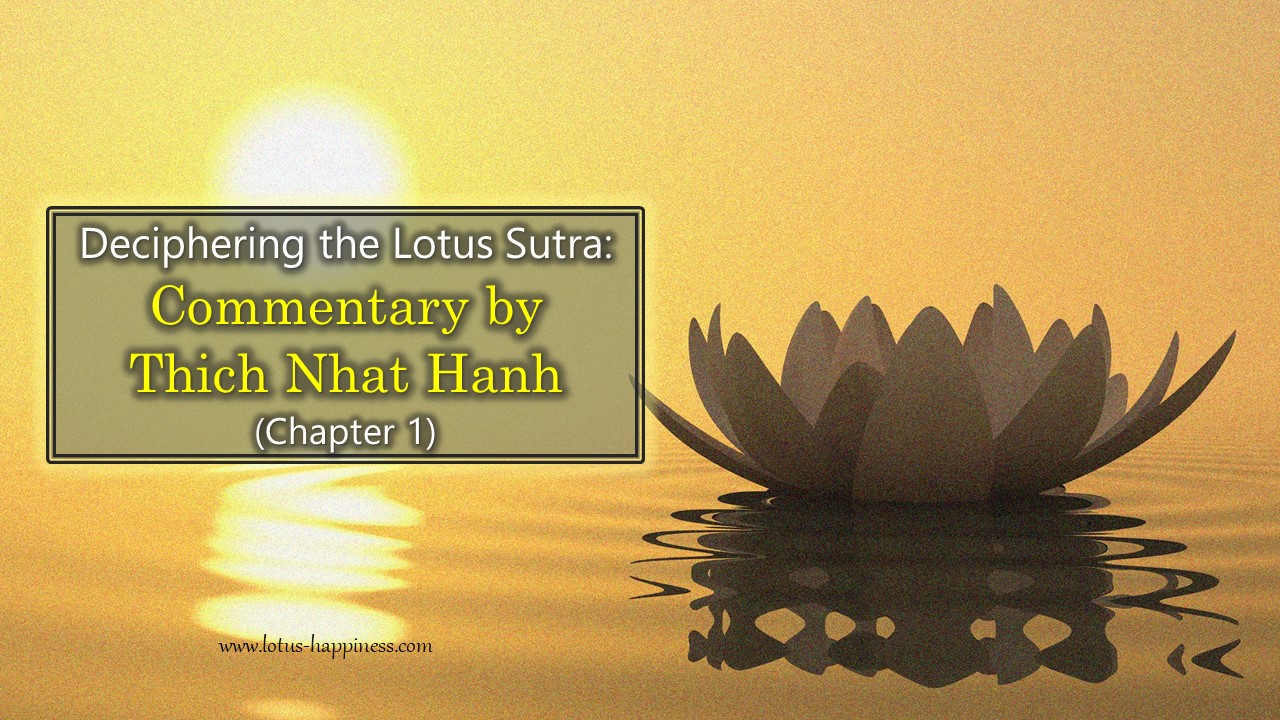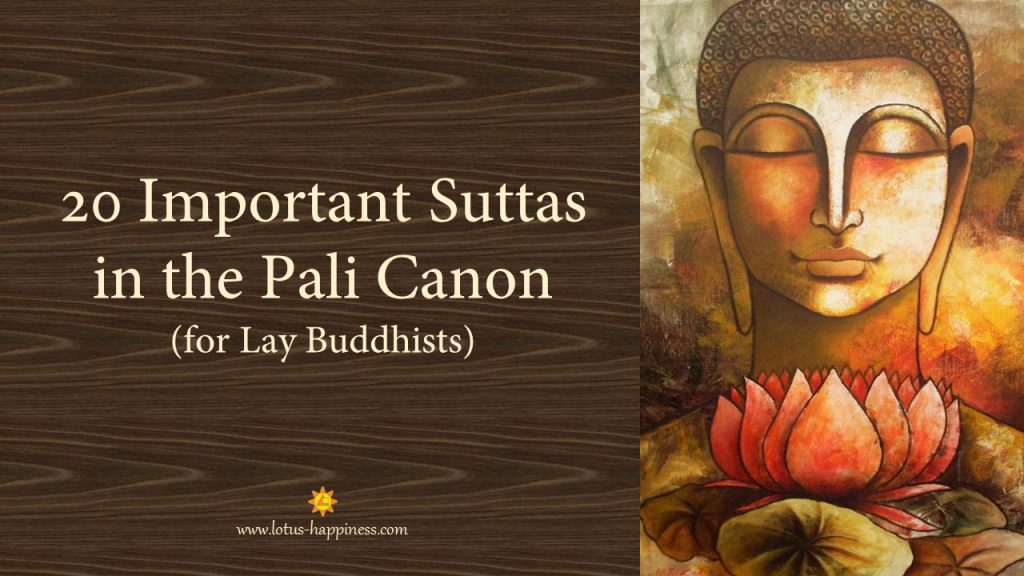
20 Important Suttas in the Pali Canon (for Lay Buddhists)
There are tonnes of gems in the Pali Canon suttas of the Theravada Buddhist tradition. Many of these suttas have splendid wisdom about the world we live as well as insights for practical applications in daily lives.
Most Buddhists are householders or lay practitioners, as opposed to monastic monks or nuns. Hence, the focus in the selection of the 20 important suttas is predominantly for lay Buddhists. You will find suttas that are related to wealth and personal relationships, in addition to the key Dhamma teachings.
While it is impossible to list all the equally wonderful suttas, the following 20 suttas are considered the most essential and useful from the perspective of a lay Buddhist:
Sutta #1: Dhammacakkapavattana Sutta
Dhammacakkapavattana Sutta (Setting the Dharma Wheel in Motion) is the discourse on Four Noble Truths and Eightfold Path. This is the first sermon by the Buddha at Deer Park, Sarnath. Together with Anattalakkhana Sutta (2nd turning of the Wheel) and Aditta-pariyaya Sutta (3rd turning of the Wheel), these three suttas form the three cardinal teachings within the Pali traditions.
“And what is the middle way realized by the Tathagata that — producing vision, producing knowledge — leads to calm, to direct knowledge, to self-awakening, to Unbinding? Precisely this Noble Eightfold Path: right view, right resolve, right speech, right action, right livelihood, right effort, right mindfulness, right concentration. This is the middle way realized by the Tathagata that — producing vision, producing knowledge — leads to calm, to direct knowledge, to self-awakening, to Unbinding.
“Now this, monks, is the noble truth of stress: Birth is stressful, aging is stressful, death is stressful; sorrow, lamentation, pain, distress, & despair are stressful; association with the unbeloved is stressful, separation from the loved is stressful, not getting what is wanted is stressful. In short, the five clinging-aggregates are stressful. – Dhammacakkapavattana Sutta
Sutta #2: Anattalakkhana Sutta
Anattalakkhana Sutta, the second cardinal discourse by the Buddha, is about the teaching on the nature of impermanence, change, and non-self of the five skandhas. Disciples are taught to release attachment and clinging to impermanent objects in the material world.
“Bhikkhus, when a noble follower who has heard (the truth) sees thus, he finds estrangement in form, he finds estrangement in feeling, he finds estrangement in perception, he finds estrangement in determinations, he finds estrangement in consciousness.
“When he finds estrangement, passion fades out. With the fading of passion, he is liberated. When liberated, there is knowledge that he is liberated. He understands: ‘Birth is exhausted, the holy life has been lived out, what can be done is done, of this there is no more beyond.'” – Anattalakkhana Sutta
Sutta #3: Aditta-pariyaya Sutta
Aditta-pariyaya Sutta is the 3rd cardinal discourse of the Buddha. Popularly known as the Fire Sermon, this sutta is about the teaching on achieving liberation from suffering through detachment from the six senses. Another related sutta about the purification of six senses is Chachakka Sutta.
The Buddha applies skillful means to teach in this case. According to post-canonical Pali commentary attributed to Buddhaghosa, the Buddha was said to reflect: ‘What kind of Dhamma talk would be suitable for them?’ Knowing that these ascetics performed a sacred fire ritual, the Buddha adapted his teaching by incorporating the element of fire in his sermon so that his listeners could understand his teaching.
“Monks, the All is aflame. What All is aflame? The eye is aflame. Forms are aflame. Consciousness at the eye is aflame. Contact at the eye is aflame. And whatever there is that arises in dependence on contact at the eye — experienced as pleasure, pain or neither-pleasure-nor-pain — that too is aflame. Aflame with what? Aflame with the fire of passion, the fire of aversion, the fire of delusion. Aflame, I tell you, with birth, aging & death, with sorrows, lamentations, pains, distresses, & despairs. – Aditta-pariyaya Sutta
Sutta #4: Satipaṭṭhāna Sutta
Satipaṭṭhāna Sutta and the Mahāsatipaṭṭhāna Sutta are two of the most popular suttas in the Pali Canon. The four foundation of mindfulness of the body, feelings/sensations, mind/consciousness, and dhammās are found in this sutta. Teachings such as the five hindrances, five aggregates of clinging, six internal and external sense bases, and seven factors of enlightenment are taught in this sutta as well.
And how does a monk live contemplating the body in the body?
Herein, monks, a monk, having gone to the forest, to the foot of a tree or to an empty place, sits down with his legs crossed, keeps his body erect and his mindfulness alert.
Ever mindful he breathes in, mindful he breathes out. Breathing in a long breath, he knows, “I am breathing in a long breath”; breathing out a long breath, he knows, “I am breathing out a long breath”; breathing in a short breath, he knows, “I am breathing in a short breath”; breathing out a short breath, he knows, “I am breathing out a short breath.”
“Experiencing the whole (breath-) body, I shall breathe in,” thus he trains himself. “Experiencing the whole (breath-) body, I shall breathe out,” thus he trains himself. “Calming the activity of the (breath-) body, I shall breathe in,” thus he trains himself. “Calming the activity of the (breath-) body, I shall breathe out,” thus he trains himself. – Satipaṭṭhāna Sutta
Sutta #5: Ānāpānasati Sutta
Ānāpānasati Sutta is a discourse by the Buddha on how to use the awareness of breath (anapana) as an initial focus for meditation. This sutta and the Mahāsatipaṭṭhāna Sutta constitute the basics of vipassana/mindfulness meditation.
“Mindfulness of in-&-out breathing, when developed & pursued, is of great fruit, of great benefit. Mindfulness of in-&-out breathing, when developed & pursued, brings the four frames of reference to their culmination. The four frames of reference, when developed & pursued, bring the seven factors for awakening to their culmination. The seven factors for awakening, when developed & pursued, bring clear knowing & release to their culmination. – Ānāpānasati Sutta
Sutta #6: Kalama Sutta
Kalama Sutta is the famous discourse on free inquiry. The Kalamas of Kesaputta sought guidance from the Buddha because there were monks and brahmans who expounded only their own doctrines and despised the doctrines of others. They were doubtful which of these monks or brahmans spoke the truth. The Buddha replied that it was alright to be doubtful and provided a guideline for them to critically investigate the validity of the various teachings.
“Come, Kalamas. Do not go upon what has been acquired by repeated hearing; nor upon tradition; nor upon rumor; nor upon what is in a scripture; nor upon surmise; nor upon an axiom; nor upon specious reasoning; nor upon a bias towards a notion that has been pondered over; nor upon another’s seeming ability; nor upon the consideration, ‘The monk is our teacher.’ Kalamas, when you yourselves know: ‘These things are good; these things are not blamable; these things are praised by the wise; undertaken and observed, these things lead to benefit and happiness,’ enter on and abide in them. – Kalama Sutta
Sutta #7: Cakkavati Sutta
Cakkavati Sutta is the only sutta in the Pali Canon in which the Buddha predicts the future birth and appearance of Buddha Metteya (Maitreya). While innumerable Buddhas and bodhisattvas are mentioned in the Mahayana sutras, Buddha Metteya is the only Buddha that has been mentioned by Shakyamuni Buddha in the Pali Canon.
In this sutta, the Buddha also teaches about the true meaning of long life, beauty, happiness, wealth, and strength.
One of the most famous quotes found in this sutta is:
“Monks, live with yourself as your island, yourself as your refuge, with nothing else as your refuge. Live with the Dhamma as your island, the Dhamma as your refuge, with nothing else as your refuge.” – Cakkavati Sutta
Sutta #8: Cula-suññata Sutta
Cula-suññata Sutta, also known as the Lesser Discourse on Emptiness, is a teaching about emptiness – a pivotal doctrine in the Mahayana traditions.
“Ananda, whatever contemplatives and brahmans who in the past entered & remained in an emptiness that was pure, superior, & unsurpassed, they all entered & remained in this very same emptiness that is pure, superior, & unsurpassed. Whatever contemplatives and brahmans who in the future will enter & remain in an emptiness that will be pure, superior, & unsurpassed, they all will enter & remain in this very same emptiness that is pure, superior, & unsurpassed. Whatever contemplatives and brahmans who at present enter & remain in an emptiness that is pure, superior, & unsurpassed, they all enter & remain in this very same emptiness that is pure, superior, & unsurpassed.
“Therefore, Ananda, you should train yourselves: ‘We will enter & remain in the emptiness that is pure, superior, & unsurpassed.'” – Cula-suññata Sutta
Sutta #9: Samadhi Sutta
Samadhi Sutta is about the four concentration (jhana) that will result in the four benefits: pleasant abiding in the here and now, attainment of knowledge and vision, mindfulness and alertness, and the ending of the effluents (rebirth). Another related sutta is Samadhanga Sutta, a discourse on five-factored noble right concentration (jhana) and the spiritual benefits of upon mastering meditation.
“Monks, these are the four developments of concentration. Which four? There is the development of concentration that, when developed & pursued, leads to a pleasant abiding in the here & now. There is the development of concentration that, when developed & pursued, leads to the attainment of knowledge & vision. There is the development of concentration that, when developed & pursued, leads to mindfulness & alertness. There is the development of concentration that, when developed & pursued, leads to the ending of the effluents. – Samadhi Sutta
Sutta #10: Mahanama Sutta
Mahanama Sutta is a sutta on the ways of a lay Buddhist. The Buddha expounds the teaching of taking refuge in the Triple Gem and Five Precepts. Another related sutta is Dhammika Sutta.
“Venerable sir, in what way is one a lay follower?”
“Mahanama, inasmuch as one has gone to the Buddha for refuge, has gone to the Dhamma for refuge, has gone to the Sangha for refuge; in that way, Mahanama, one is a lay follower.” – Mahanama Sutta
Sutta #11: Upanisa Sutta
Upanisa Sutta is the discourse on Dependent Origination which is also known as Dependent Co-arising, or Twelve-linked Chains of Causation. Dependent Origination is a teaching of the process of life which involves birth, aging, illness, and death – a process that has its anchor upon the Law of Cause and Effect.
“The knowledge of ending in the presence of ending has its prerequisite, I tell you. It is not without a prerequisite. And what is the prerequisite for the knowledge of ending? Release, it should be said. Release has its prerequisite, I tell you. It is not without a prerequisite. And what is its prerequisite? Dispassion… Disenchantment… Knowledge & vision of things as they actually are present… Concentration… Pleasure… Serenity… Rapture… Joy… Conviction… Stress… Birth… Becoming… Clinging… Craving… Feeling… Contact… The six sense media… Name-&-form… Consciousness… Fabrications… Fabrications have their prerequisite, I tell you. They are not without a prerequisite. And what is their prerequisite? Ignorance, it should be said. – Upanisa Sutta
Sutta #12: Dighajanu (Vyagghapajja) Sutta
In Dighajanu (Vyagghapajja) Sutta, the Buddha instructs rich householders on how to preserve and increase their prosperity and how to avoid loss of wealth. Similar to Dighajanu Sutta on the subject of wealth is Adiya Sutta – a sutta about the benefit of obtaining righteous wealth.
The factors for the accumulation of wealth are persistent efforts, vigilance, good friendship and balanced livelihood. The factors for the dissipation of wealth are debauchery, drunkenness, gambling, associate with evil-doers. The factors for spiritual progress are faith, virtue, charity, and wisdom.
[The Blessed One said:] “There are these four qualities, TigerPaw, that lead to a lay person’s happiness and well-being in this life. Which four? Being consummate in initiative, being consummate in vigilance, admirable friendship, and maintaining one’s livelihood in tune. – Dighajanu (Vyagghapajja) Sutta
Sutta #13: Parabhava Sutta
Parabhava Sutta is a discourse about 23 causes that will bring downfall to people. Some of these causes include: not cherishing the Dharma, laziness, living a life of debauchery, excessive drinking, unscrupulous gambling, womanizing, stinginess etc.
The Deity:
Having come here with our questions to the Exalted One, we ask thee, O Gotama, about man’s decline. Pray, tell us the cause of downfall!
The Buddha:
Easily known is the progressive one, easily known he who declines. He who loves Dhamma progresses; he who is averse to it, declines. – Parabhava Sutta
Sutta #14: Kaccayanagotta Sutta
Kaccayanagotta Sutta is a discourse on Right View and the Middle Way. Nagarjuna quoted Kaccayanagotta Sutta in his work Fundamental Verses on the Middle Way:
“Everything exists”: That is one extreme.
“Everything doesn’t exist”: That is a second extreme.
Avoiding these two extremes,
The Tathagata teaches the Dhamma via the middle. – Kaccayanagotta Sutta
Sutta #15: Sigolovada Sutta
Sigolovada Sutta is the Buddha’s guidance on how to live with peace and happiness for lay Buddhist. One day when Sigala was worshipping the six directions of the East, South, West, North, the Nadir and the Zenith each morning, the Buddha came along to teach him the meaning to this ritual. This sutta covers basic morality, how to build, manage, and protect one’s wealth, how to associate with virtuous friends, and how to maintain good relationship with people such as husband/wife, parents/children, teachers/students, employers/employees, friends/associates.
“In five ways, young householder, should a wife as the West be ministered to by a husband:
(i) by being courteous to her, (ii) by not despising her, (iii) by being faithful to her, (iv) by handing over authority to her, (v) by providing her with adornments.“The wife thus ministered to as the West by her husband shows her compassion to her husband in five ways:
(i) she performs her duties well, (ii) she is hospitable to relations and attendants[10] (iii) she is faithful, (iv) she protects what he brings, (v) she is skilled and industrious in discharging her duties.“In these five ways does the wife show her compassion to her husband who ministers to her as the West. Thus is the West covered by him and made safe and secure. – Sigolovada Sutta
Sutta #16: Mettā Sutta
Metta Sutta, or Karaṇīyamettā Sutta, is a discourse on loving-kindness and compassion, the virtues of which have the power of protection. Here is the background story: a group of monks, frightened by the spirits in the forest where the Buddha had sent them to practice meditation, sought the Buddha’s assistance. The Buddha expounded the Mettā Sutta as an antidote for fear. As a result of the loving-kindness exuded by the monks, the spirits were appeased and they no longer harassed the monks.
“Whatever living beings there may be — feeble or strong (or the seekers and the attained) long, stout, or of medium size, short, small, large, those seen or those unseen, those dwelling far or near, those who are born as well as those yet to be born — may all beings have happy minds. – Metta Sutta
Sutta #17: Mangala Sutta
Mangala Sutta is a short discourse on blessings. On one occasion when the Buddha was dwelling in Jeta’s Grove near Savatthi, a deity came down to ask the Buddha on what was the greatest blessing. The Buddha expounded the 38 blessings, some of these blessings are:
“Not to associate with the foolish, but to associate with the wise; and to honor those who are worthy of honor — this is the greatest blessing.”
To support mother and father, to cherish wife and children, and to be engaged in peaceful occupation — this is the greatest blessing.
To be respectful, humble, contented and grateful; and to listen to the Dhamma on due occasions — this is the greatest blessing. – Mangala Sutta
Sutta #18: Aggañña Sutta
Aggañña Sutta is a sutta on the knowledge of beginnings; the genesis and evolution of the Universe before the Big Bang. Moral degradation in general, and greed in particular, are the key factors that give birth to the physical aspect of the Universe.
“At that period, Vasettha, there was just one mass of water, and all was darkness, blinding darkness. Neither moon nor sun appeared, no constellations or stars appeared, night and day were not distinguished, nor months and fortnights, no years or seasons, and no male and female, beings being reckoned just as beings. And sooner or later, after a very long period of time, savoury earth spread itself over the waters where those beings were. It looked just like the skin that forms itself over hot milk as it cools. It was endowed with colour, smell and taste. It was the colour of fine ghee or butter, and it was very sweet, like pure wild honey. – Aggañña Sutta
Sutta #19: Brahmajala Sutta
In Brahmajala Sutta, the Buddha elaborates on the precepts that will enable one to gain respect from people. In addition, the Buddha also reveals the truth about Brahma who is the Godhead as found the Abrahamic faiths in the Judeo-Christian and Islamic traditions. Those who wish to discover about the truth about creator God directly from Shakyamuni Buddha himself, then look no further, just read the Brahmajala Sutta.
“Thereupon the being who re-arose there first thinks to himself: ‘I am Brahmā, the Great Brahmā, the Vanquisher, the Unvanquished, the Universal Seer, the Wielder of Power, the Lord, the Maker and Creator, the Supreme Being, the Ordainer, the Almighty, the Father of all that are and are to be. And these beings have been created by me. What is the reason? Because first I made the wish: “Oh, that other beings might come to this place!” And after I made this resolution, now these beings have come.’ – Brahmajala Sutta (verse 42)
Sutta #20: Mahaparinibbana Sutta
Mahaparinibbana Sutta is a final discourse before the Buddha entered Mahaparinibbana.
And the Blessed One addressed the bhikkhus, saying: “Behold now, bhikkhus, I exhort you: All compounded things are subject to vanish. Strive with earnestness!” This was the last word of the Tathagata. – Mahaparinibbana Sutta
If you find this blogpost useful, beneficial, and practical for your Buddhist practice, do share the joy of Dhamma with your family and friends. Do subscribe to Lotus Happiness for future updates and give a Like in our Facebook page.


